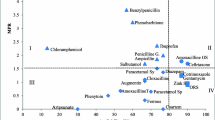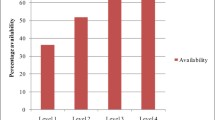Abstract
Objective To evaluate availability, affordability and prescribing pattern of medicines in both public and private health sectors of Sudan. Setting Availability, affordability, and rational use of medicines were evaluated in primary health care centers in six states of Sudan. Methods The survey followed the WHO guidelines for monitoring and assessing the pharmaceutical situation in countries. For this survey, a total of 36 public health facilities selected from the six geographic areas were identified. Main outcome measure The survey confirmed the good availability and acceptable affordability of essential medicines in the public health centers and private pharmacies. Despite acceptable stocking of the medicines in these facilities, storage quality of medicines was low. Results On average, 82% of the core medicines monitored were available in the centers and 85% of the medicines prescribed by the physician were dispensed to the patients. The average score for quality of storage in store room and dispensing were 56% and 65%, respectively. On average, a complete course of treatment of malaria in public centers costs 0.62 and for treatment of pneumonia in adults and children costs 3.13 and 0.57 days of the lowest government salary, respectively. The average number of medicines per prescription was 2.3. On average, the number of prescriptions containing at least one antibiotic was 66% and 27% of the prescriptions containing an injectable medicine. Adherence of prescribers to standard treatment guidelines for treating uncomplicated diarrhea and diarrhea was 45% and 64%, respectively. The acceptable medicine labeling criteria were met only in 50% of the prescriptions. Conclusion The overall availability of essential medicines in the public health centers and private pharmacies of Sudan was acceptable. Although affordability of medicines for some common diseases such as malaria and child pneumonia could be considered acceptable, it was much higher for some other conditions including adult pneumonia. Prescription of antibiotics was high and adherence to standard treatment guidelines for managing common and widely spread diseases such as diarrhea and malaria was low.
Similar content being viewed by others
References
WHO EMRO-country profiles, Sudan. (document on the Internet), World Health Organization, 2008. http://www.emro.who.int/emrinfo/index.asp?Ctry=sud.
Mustafa MH, Babiker MA. Economic cost of malaria on households during a transmission season in Khartoum state, Sudan. East Mediterr Health J. 2007;13(6):1298–307.
Witter S. Archiving sustainability, quality and access: lessons from the world’s largest revolving medicine fund in Khartoum. East Mediterr Health J. 2007;13(6):1476–85.
WHO operational package for monitoring and assessing country pharmaceutical situations (document on the Internet). World Health Organization, 2005. http://archives.who.int/tbs/monitoring/workingdraft.pdf.
Cheraghali AM, Nikfar S, Behmanesh Y, Rahimi V, Habibipour F, Tirdad T, et al. Evaluation of availability, accessibility and prescribing pattern of medicines in the Islamic Republic of Iran. East Mediterr Health J. 2004;10:406–15.
Bosu WK, Ofori-Adjei D. An audit of prescription practices in health care facilities of the Wassa West district of Ghana. West Afr J Med. 2000;19(4):298–303.
Mallet HP, Njikam A, Scouflaire SM. Evaluation of prescription practices and of the rational use of medicines in Niger. Sante. 2001;11(3):185–93.
Enwere OO, Falade CO, Salako BL. Medicine prescribing pattern at the medical outpatient clinic of a tertiary hospital in southwestern Nigeria. Pharmacoepidemiol Drug Saf. 2007;16(11):1244–9. doi:10.1002/pds.1475.
Kamaruzaman S, Mohamed IMI. Are essential medicines in Malaysia accessible, affordable and available? Pharm World Sci. 2005;27:442–6. doi:10.1007/s11096-005-1318-8.
Van Staa A, Hardon A. Injection practices in the developing world. Results and recommendations from field studies in Uganda and Indonesia (document on the Internet). World Health Organization, 1996 (WHO/DAP/96.4). http://www.who.int/medicinedocs/collect/medicinedocs/pdf/s2232e/s2232e.pdf.
Acknowledgements
Survey’s data collected by Dr. Mayada M. Ahmed, Dr. Nabiha Kamal Eldien, Dr. Arwa Kambal, Ms. Wamda Ahmed, Ms. Iman Abd Ellah, Dr. Ismaeel Abd Elkariem, Dr. Ahmed M. Eldhaw, Dr. El mahi Ahmed, Dr. Yaser Bagdadi, Dr. Iqubal Mohammed, Dr. Tariq Ibrahim, Dr. Khalid Eltigani, Dr. Mohand Mohammed, Dr. Hamid Dhaw Elbiet, Dr. Ammar M. Ommeiri, Dr. Aymen E. Ahmed, Dr. Eisaa A. Hassan, Dr. Walied Elzaki, Dr. Elsaoi E. Ibrahim, Dr. Mohanad Elhafiz, Dr. Eltayeb Ahmed, Dr. Elrashied Ibrahim, Dr. Waeil Salih, Yasien H. Mohamed, Dr. Mohamed Motwakil and Dr. Yeosif A. Salah.
Funding
This project was supported technically and financially by WHO/EMRO.
Conflict of interest
A.M. Cheraghali was a WHO/EMRO short-term consultant.
Author information
Authors and Affiliations
Corresponding author
Rights and permissions
About this article
Cite this article
Cheraghali, A.M., Idries, A.M. Availability, affordability, and prescribing pattern of medicines in Sudan. Pharm World Sci 31, 209–215 (2009). https://doi.org/10.1007/s11096-009-9282-3
Received:
Accepted:
Published:
Issue Date:
DOI: https://doi.org/10.1007/s11096-009-9282-3




